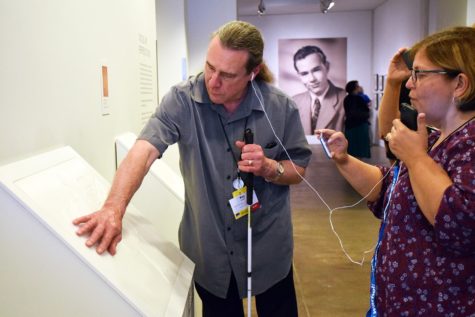This is the fifth post in a series about the development process of The Warhol’s new audio guide.
Since the beginning of this year, we’ve been developing Out Loud, The Warhol’s new audio guide, and I’m excited to announce that we are launching it on October 25. The app is available to download for iOS devices from the App Store; visitors to the museum can also borrow a device at the museum for free.
I’m proud of Out Loud because it is truly the result of working directly with users, employing user-centered design and agile development processes to shape the final product. While the app offers perspectives and information on Andy Warhol that we hope all visitors will enjoy, we took on an inclusive design process and built the app with visitors who are blind or have low vision in mind.
The best way of understanding our users’ needs was to go straight to the source. Before we drew a single wireframe or wrote a single line of code, the app team talked to partners with visual impairments about how technology can be used to strengthen a museum experience. For both technical and audio content development we treated user testing sessions as milestones, moments to test specific features. What we learned during a session would dictate the direction we would take, whether that meant scrapping a particular design or re-editing audio to tell more concise and engaging stories.
We also tested the app at every opportunity possible. In mid-July, we hosted a Pittsburgh-area Accessibility Meetup at The Warhol in which community members with different abilities came to test the app. It was quite humbling: we learned that, no matter how well-designed the technology is, an audio guide is only as good as the museum experience around it. Everything, from the visitor services representative who hands a device to a visitor at the admission desk to the kind of headphones we offer, can make or break the experience. We applied these learnings in early August when we presented the app to our colleagues in town for the Leadership Exchange in Arts and Disability conference.
We continue to see Out Loud as a work in progress. You could consider the Out Loud we’re launching now a beta version, a way for us to publicly test the ideas we’ve been working on for the past nine months before we expand it further. This version includes content for the seventh floor of our museum, covering Warhol’s life through early 1962, the moment right before he produces his most iconic works. We’ll be collecting feedback from visitors to help shape how we tell stories about this prolific, multifaceted, and often contradictory artist.
Gallery attendants manning our admission desk often tell me that one of the requests they receive the most from visitors is an audio guide. I’m thrilled that, with the launch of Out Loud, we’ll now be able to offer new and diverse perspectives on Warhol’s life and art in an engaging way. Even more exciting than opening up new perspectives on Warhol’s work is opening up the museum to audiences that might not always feel comfortable here. In the video above, Ann Lapidus, one of the community partners whose honest and continual input was pivotal to creating the app, describes how Out Loud is innovative because it allows people with visual impairments to enjoy a full and independent experience at the museum.
Whether or not you’re in Pittsburgh, you can be our next user tester. Download the app today, or borrow one of our devices for free at the museum, and let us know what you think!
Accessibility initiatives at The Warhol are generously supported by Allegheny Regional Asset District, The Edith L. Trees Charitable Trust, and the FISA Foundation in honor of Dr. Mary Margaret Kimmel.
